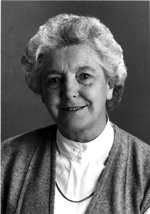Winifred Watkins facts for kids
Quick facts for kids
Winifred Watkins
|
|
|---|---|
 |
|
| Born | 6 August 1924 Shepherd's Bush, London, England
|
| Died | 3 October 2003 (aged 79) |
| Employer | University of London |
| Awards | Paul Ehrlich and Ludwig Darmstaedter Prize (1969) |
Winifred May Watkins (6 August 1924 – 3 October 2003) was a very important British scientist. She was a biochemist, which means she studied the chemistry of living things. She also taught and did research at universities, like the Imperial College School of Medicine. She was known for her amazing work on blood groups.
Early Life and Education
Winifred Watkins was born in London, England, on August 6, 1924. Her father was an engraver, someone who carves designs, but he also loved art.
Winifred became interested in science after she won a scholarship. This scholarship allowed her to attend The Godolphin and Latymer School for Girls in Hammersmith. In 1939, during World War II, her school had to move out of London quickly. Winifred returned to London after about a year.
She originally wanted to study medicine. However, because of the war, she had to work while she studied at the Chelsea Polytechnic. During this time, she began working with another scientist named Walter Thomas James Morgan. They worked together for many years. Winifred even got special permission to be named on a science paper with him, even though she didn't have all the usual degrees yet.
In 1947, she earned a degree in Physics and Chemistry from London University. She then continued her studies at St Bartholomew's Hospital Medical School. In 1950, she earned her doctorate degree in biochemistry from the University of London.
Amazing Work on Blood Groups
Winifred Watkins spent her career studying blood. Specifically, she focused on blood groups. Blood groups are different types of blood that people have. Knowing a person's blood group is very important for things like blood transfusions.
She joined a special group of scientists at the Lister Institute who were also studying blood. In 1965, she became a Reader in biochemistry at the University of London. This is a high academic position. Just three years later, in 1968, she became a full Professor.
Winifred published a very important paper that helped explain how blood groups are made in the body. This discovery was a big deal! Because of her important work, she received funding to continue her research at the University of California in the United States.
Awards and Recognition
Winifred Watkins received many awards for her contributions to science. Her work was especially important for understanding blood transfusions.
In 1969, she was elected a Fellow of the Royal Society (FRS). This is a very high honor for scientists in the United Kingdom. The next year, in 1970, she became a Fellow of the University of London.
In 1988, the Royal Society gave her the Royal Medal. This is another very important award for scientific achievement. She also became a member of the Royal Swedish Academy of Sciences. They recognized her for her "fundamental contributions" to understanding how different types of sugars are made on cell surfaces and in body fluids. This helped scientists understand more about how our bodies work at a tiny level.

